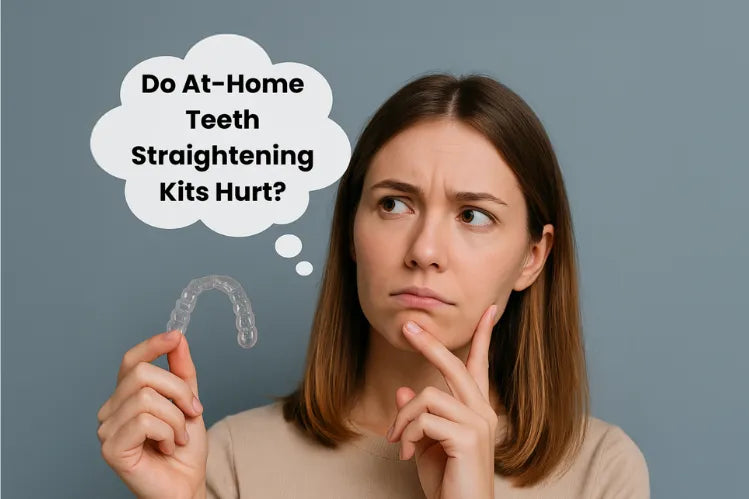
Tabla de contenido
- ¿Es común que los kits caseros para enderezar los dientes causen algún dolor?
- Causas típicas de molestias con los alineadores
- ¿Qué hacer si le duele usar el kit de enderezamiento dental en casa?
- Cuándo contactar a su empresa de alineadores
- ¿Se puede prevenir el dolor causado por los alineadores?
- Kit de enderezamiento dental casero para dientes doloridos
- Preguntas frecuentes
La alineación de dientes en casa con alineadores transparentes es una forma fácil, asequible y discreta de Observa una mejora en tu sonrisa. Pero, ¿qué hacer con el dolor del kit de alineación dental casero? Una pequeña molestia puede... Es de esperarse, después de todo, los alineadores están moviendo los dientes a una mejor posición. Pero si el dolor persiste o se agudiza, por lo que podría valer la pena contactar a su ortodoncista. En este blog, le ayudaremos a navegar por Dolor natural que puede experimentar durante el tratamiento.
¿Es común que? ¿Los kits caseros para enderezar los dientes pueden causar dolor?
Sí, es totalmente normal sentir un poco de dolor. Cuando empieces a usar tus alineadores o Al cambiar a un nuevo juego, los dientes comienzan a moverse. Hay una leve incomodidad porque la presión está haciendo... Sus dientes se mueven: esto es especialmente cierto en los primeros días de usar una bandeja nueva.
Compáralo con hacer ejercicio después de un largo descanso. Es posible que te sientas adolorido porque estás... Acostumbrarse de nuevo a la actividad física. Los dientes y las mandíbulas responden de forma similar cuando están bajo control. presión. Sin embargo, existe una diferencia entre el dolor normal al adaptarse a los nuevos alineadores y el dolor indicando que algo anda mal.
Causas típicas de molestias con los alineadores
A continuación se presentan algunas causas comunes de incomodidad con los alineadores domésticos:
Presión de una bandeja nueva
Cada nuevo alineador está hecho para mover los dientes un poco más, por lo que la presión puede causar molestias leves. dolor, especialmente en las primeras 48-72 horas de uso de la nueva bandeja.
Bordes ásperos o afilados
En ocasiones, los bordes de sus alineadores pueden no ser lisos y pueden rozar sus mejillas. encías o lengua, causando irritación o pequeños cortes.
Mal ajuste
Si un alineador está demasiado apretado, demasiado flojo o no se ajusta correctamente a sus dientes, puede ser necesario incómodo y los alineadores no van a mover tus dientes correctamente.
Usar bandejas demasiado largas o demasiado cortas
Usar las bandejas durante demasiado tiempo (más de 10 a 14 días, por ejemplo) hace que Corregir excesivamente los dientes y usarlos muy poco (menos de las horas recomendadas cada día) puede causar tirantez al intentar ponérselos de nuevo.
Problemas dentales preexistentes
Problemas como caries en los dientes, enfermedades de las encías y la presencia de muelas del juicio pueden... Hacer que el uso de alineadores sea doloroso. Es importante resolver estos problemas antes de comenzar el tratamiento.
¿Qué hacer si le duele usar el kit de enderezamiento dental en casa?
Dado que hemos identificado las posibles causas de su dolor, aquí hay algunas formas de controlarlo. Dolor y garantizar el bienestar dental:
No los quites
Quitarse los alineadores antes de tiempo puede ser tentador, pero no lo haga. Puede prolongar el tratamiento. Espere un par de días; a menudo, la boca tarda de 2 a 3 días en adaptarse.
Utilice cera de ortodoncia
Si hay un área específica que le está haciendo moretones en las encías o las mejillas, coloque cera de ortodoncia en ese borde afilado; proporciona un amortiguador entre la piel y el alineador.
Lime suavemente los bordes afilados
Algunas marcas permiten el uso de una lima de uñas o esmeril limpio para redondear los bordes afilados. Nuevamente, siempre consulte primero con su proveedor. Le sugerimos que llame a su proveedor si tiene alguna inquietud importante.
Los Chewies pueden ayudar a un mejor ajuste
Los Chewies son pequeños cilindros de espuma diseñados para facilitar la correcta colocación de su Alineadores. Si la bandeja no encaja en su lugar, masticar caramelos masticables varias veces al día puede aliviar la rigidez. y ayudar a que se ajuste mejor.
Compresa fría o analgésico
Aplicar una compresa fría o tomar un analgésico (es decir, ibuprofeno) puede ayudar a aliviar la hinchazón. y dolor, especialmente durante los primeros días de usar una nueva bandeja.
Coma alimentos blandos
Evite los alimentos crujientes o masticables cuando tenga dolor. Opte por los blandos.
Use los alineadores de manera constante
Para obtener los mejores resultados, úselos de 20 a 22 horas diarias. Si no se usan, pueden quedar mal ajustados. y causar dolor al volver a colocarlos.
Cuándo contactar a su empresa de alineadores
Es esperable que sienta algo de dolor, pero en estos casos, comuníquese con su proveedor:
- Dolor que dura más de 5 días
- Una bandeja agrietada o deformada
- Encías que sangran o llagas que no cicatrizan
- Bandejas que no encajan a pesar de usar masticables
- Empeoramiento del dolor de mandíbula, dolores de cabeza o problemas de mordida
Es posible que le recomienden volver a una bandeja anterior, enviar impresiones actualizadas o reemplazarlas. El alineador. Muchas empresas ofrecen soporte remoto, así que aprovéchalo.
¿Se puede prevenir el dolor causado por los alineadores?
No puedes evitar todas las molestias, pero aquí te mostramos cómo aliviar el dolor de los alineadores:
Primero hazte un chequeo dental
Trate cualquier caries, dolor de encías o muelas del juicio antes de comenzar.
Cumplir con el horario
Cambie las bandejas a tiempo y úselas según lo recomendado cada día.
Utilice Chewies de inmediato
Ayudan a que sus alineadores se ajusten mejor y pueden reducir las molestias.
Mantenga los alineadores limpios
Los alineadores sucios pueden causar irritación de las encías. Enjuágalos, cepíllalos y usa productos de limpieza adecuados. regularmente.
Kit de enderezamiento dental casero para dientes doloridos
La incomodidad es una indicación de que estás progresando; sin embargo, debes comunicarte si Si experimenta sangrado, mayor incomodidad o si sus bandejas se ajustan de manera diferente. Los alineadores caseros facilitan las cosas. Es más conveniente, pero aún requiere diligencia en el cuidado dental. Asegúrate de usar tus bandejas constantemente, toma Anote cualquier molestia y mantenga informado a su médico en cualquier momento si algo no está bien. Una sonrisa más recta... No será posible sin dolor, pero si todo está controlado, seguramente estarás feliz de haber ido. ¡Para el tratamiento con alineadores!
Preguntas frecuentes
1. ¿Cómo aliviar el dolor del kit de enderezamiento dental casero?
Aplicar una compresa fría o una cera de ortodoncia y tomar un analgésico de venta libre. Puede ayudar a aliviar el dolor del alineador.
2. ¿Es normal que me duelan los dientes con un kit de ortodoncia casero?
Sí, es normal que cualquier persona que se someta a un tratamiento de enderezamiento dental en casa experimente un dolor leve o moderado. Asegura que los dientes se muevan hacia la posición deseada.
3. ¿Es seguro enderezar los dientes con un kit en casa?
Sí, los kits de enderezamiento de dientes en casa incluyen alineadores transparentes, que se consideran seguros. y eficaz para problemas dentales leves a moderados. Sin embargo, asegúrese de que el tratamiento sea supervisado por un profesional dental
Citas:
Alansari RA. Percepción de los jóvenes sobre diferentes aparatos de ortodoncia (https://pubmed.ncbi.nlm.nih.gov/32606617/). Preferencia del paciente sobre la adherencia. 18 de junio de 2020;14:1011-1019. Consultado el 25/7/2022.
Asociación Dental Americana. Brackets (https://www.mouthhealthy.org/en/az-topics/b/braces). Consultado el 25/7/2022.
Asociación Dental Americana. Ortodoncia (https://www.mouthhealthy.org/en/az-topics/o/orthodontics). Consultado 25/07/2022.






